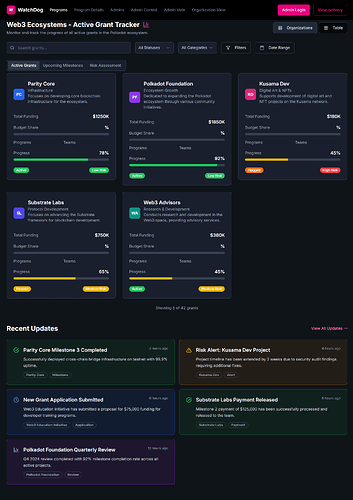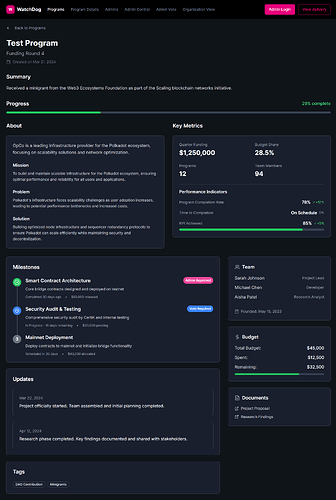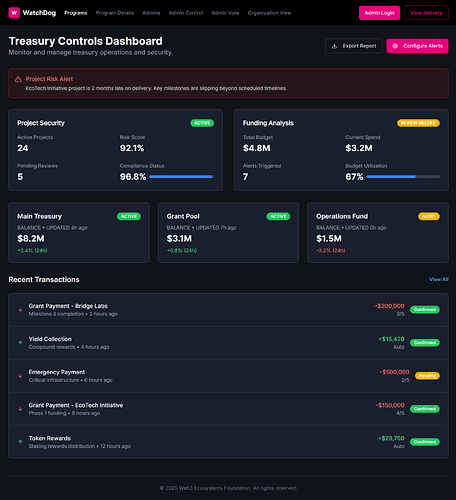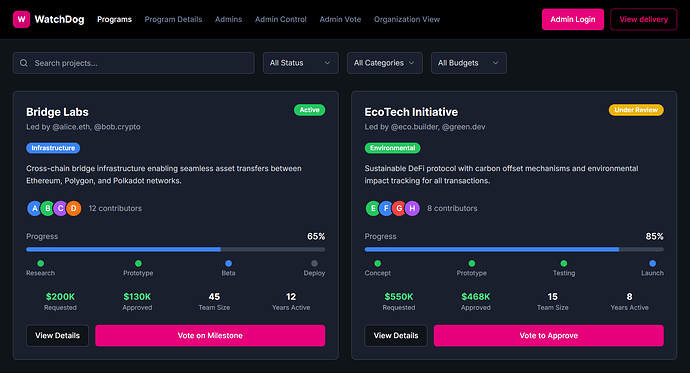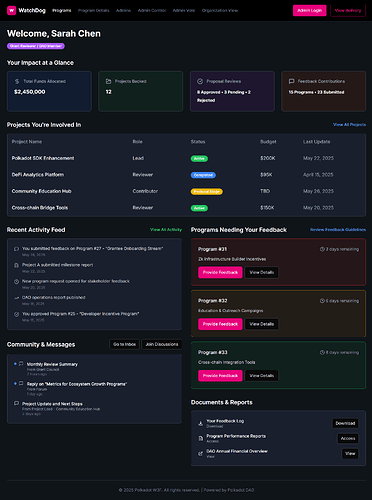Submitting this post in response to the W3F request to get feedback from the community. We are in the process of developing a Grant and Bounty Progress Tracking Dashboard for the Polkadot ecosystem, designed to provide the community with a transparent, user-friendly platform for monitoring the progress of funded proposals, project milestones, spending, and overall impact. The tracker will offer detailed milestone tracking, real-time updates, and automated alerts for deviations or delays, providing an early warning system that prevents problems rather than just reporting them after they occur. The goal is to offer unified access to all past and active grants and bounties, along with their statuses, while proactively identifying risks before they become failures and reducing poor ROI on grants and bounties.
Problem
The Polkadot network has distributed over hundreds of millions funding grants, bounties, incentive programs, ecosystem investments, and service partnerships. While this has accelerated growth, it has also outpaced the network’s ability to track, evaluate, and ensure accountability for how funds are used.
Currently, tracking the progress of the Polkadot grant and bounty progress is fragmented, with updates scattered across various update posts and channels including Forum, Polkassembly, Discord, Telegram, Twitter, etc.—creating a fragmented, inconsistent, and ultimately unreliable reporting environment. This lack of cohesion hinders stakeholders and the community’s ability to effectively oversee projects, evaluate progress, and address potential issues promptly.
Blind spots in milestone tracking, deliverables, and cross-chain activities, burying critical data on milestones, spending, and deliverables, making it difficult to gain a comprehensive view of the ecosystem, leading to increasing inefficient allocation of DOT resources. Furthermore, the lack of real-time, data-driven early warning systems hampers the timely identification of underperformance and misuse of funds. Several incidents of misuse have already surfaced, and more may go unnoticed without active monitoring.
The network needs a unified, transparent, and independent oversight to track treasury deployment and outcomes with early risk detection that can empower DOT holders and governance participants with reliable, actionable insights.
Proposed Solution
SafeGuard is a real-time, unified grant and bounty progress tracking dashboard purpose-built for the Polkadot ecosystem. It consolidates fragmented data sources into a single, transparent interface, giving stakeholders live insights into treasury spending, project progress, and outcomes via a Polkadot-branded interface. SafeGuard introduces a proactive accountability layer by combining automation, community verification, and AI-driven oversight.
The aim is to improve project transparency and accountability while reducing reporting overhead, protecting the DAO from fund misuse, eliminating noise and poor ROI on grants and bounties.
Features
Milestone Tracking: Dedicated pages for each grant and bounty, displaying key indicators (e.g., progress bars, percentages), completion status, so you can see milestones, spending, and progress at a glance.
Real-time Updates: Timely updates on milestone completion and overall project progress
Automated Alerts: Notifications for overdue milestones or significant deviations from the grant or bounty scope, delivered via in-app notifications and email
Risk Detection: Using machine learning to detect early signs of risk (delays, stalled projects, deviations, and misuse)
Data Consolidation: Consolidating fragmented data into a standardized, actionable format for the community and stakeholders, reducing noise.
Visualizations: Charts and graphs to provide a visual representation of project progress and trends
Enforced Accountability: Missed deadlines and overdue reports trigger instant flags and follow-ups. Automated tracking of project deadlines, milestones, and deliverables, with instant notifications for missed updates or progress reports.
Automated Governance Workflows: Reduce manual follow-ups on proposals for grantees, bounty recipients, and stakeholders
Grant and Bounty Impact Assessment: Tracks real-world outcomes, ecosystem contributions, adoption metrics, and long-term value creation from funded projects to measure actual ROI and community benefit.
By transforming fragmented data into verified, intelligent, and actionable insights, SafeGuard introduces a robust layer of decentralized accountability specifically designed for Polkadot’s unique architecture.
Structured Reporting Framework
Mandatory Updates from Grant Recipients:
- Bi-weekly: Status updates and blockers
- Monthly: Budget updates and key results achieved
- Final Report: Impact assessment comparing initial goals to actual outcomes
Inputs come from automated APIs and manual updates, ensuring accuracy and flexibility.
Formalizing Reporting Standards
To ensure consistent usage and reliable progress tracking, SafeGuard reporting will be a mandatory requirement for all grant recipients operating under Treasury authority. Standardizing reporting across the Polkadot ecosystem guarantees transparency, accountability, and data integrity. Following discussions with ecosystem stakeholders, this mandate will work in alignment with existing initiatives, creating a shared commitment to responsible grant oversight and ecosystem growth.
Impact and Value Proposition
By transforming reactive grant monitoring into predictive risk management, SafeGuard will:
- Prevent failed projects through early intervention based on proven failure indicators
- Improve Treasury efficiency with higher success rates through proactive project support
- Enhance community trust via transparent, data-driven accountability
- Reduce governance overhead through automated response systems
- Protect ecosystem reputation by preventing high-profile grant failures
Who is it for
SafeGuard aligns with Polkadot’s values of transparency, decentralization, and verifiability. It serves multiple stakeholder groups:
Grant and Bounty Administrators: Tools to streamline oversight, automate progress reporting, generate insights, and trigger follow-ups
DOT/KSM Holders: Visibility into how Treasury and OpenGov funds are allocated and used
OpenGov Voters: Actionable insights to inform ongoing and future decisions
Contributors, Grantees, and Bounty Recipients: Reduced manual reporting burdens and clearer expectations
Community Members: Access to a verifiable, centralized source for project updates and accountability
Team
Build Union – Aggregate Team of Web3 Builders
Build Union is a collaborative collective of talented developers, designers, strategists, and innovators dedicated to shaping the future of the decentralized web. As an aggregate team of Web3 builders, Build Union brings together diverse expertise to create cutting-edge blockchain applications, DAO services, and other decentralized solutions. We are focused on fostering innovation and accelerating the adoption of Web3 technologies.
Live link: https://watchdog2.vercel.app/
We plan to integrate this into the forum, polkassembly, and any existing grant/bounty tool for easy access. We’d love your thoughts on this initiative
SafeGuard – Tracking Grants and Bounties. Exposing Gaps. Empowering Governance.
